Black and Red (or Dark Orange) Spiders (with Pictures) – Identification Guide
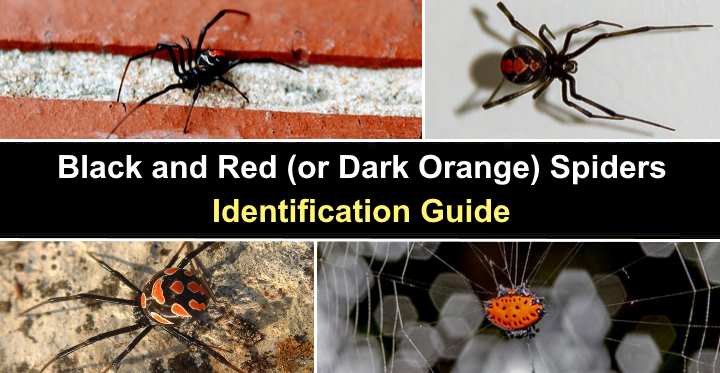
There are many types of black and red spiders you could find lurking in your house. The type of black spider with red marks that most people think of is the black widow spider. However, other black and red spiders can be jumping spiders, orb-weaver spiders, and dwarf spiders. Identifying species of red and black or black and dark orange spiders is important. Some black and red spiders are venomous, whereas others are harmless.
This article is a comprehensive guide to identifying common spiders with black and red colors. You will find that some black spiders have red backs, others are black with red or orange legs, and there are huge black spiders with red heads.
Facts About Black and Red Spiders
Like all spiders, black and red spiders are arthropods in the order Araneae and animal class Arachnida.
Unlike insects with three pairs of legs, spiders have eight legs for walking and a couple of pedipalps that look like two extra front legs. A spider’s body consists of two parts—a cephalothorax at the front and an abdomen at the rear. A spider’s eight legs connect to the cephalothorax.
With some venomous red and black spiders, the bright red dots or hourglass markings warn off predators. The black body with vibrant red marks can be on the upper side or underside of the venomous spider’s abdomen. Furry black jumping spiders can also have dark orange or red dots on their abdomen.
All black and red spiders spin webs. However, the reason for the spider webs differs between species. For example, the black widow spins messy, sticky webs to catch prey—beetles, flies, and grasshoppers. However, black and red jumping spiders use webs to lay eggs or hide.
Many types of red and black spiders have venomous bites. But, of course, the most fearful of these dark-colored spiders is the black widow. A black widow bite can cause severe pain, redness, and localized swelling. You may even notice two marks where its fangs punctured the skin. Therefore, it’s always best to seek medical attention in case of a black widow bite.
How to Identify Black and Red Spiders
To identify the species of black and red spiders, look for the distinctive shape of the red markings and abdomen form. For example, some venomous black widows have vibrant red or orange markings. However, the specific shape can help identify the particular arachnid species. Also, the type of legs and the presence of spiny hairs help with spider identification.
Types of Black and Red (or Dark Orange) Spiders (with Pictures)
Let’s look in more detail at the various identifying features of common black and red or black and dark orange spiders.
Widow Spiders (Latrodectus)
Widow spiders compose a large genus of venomous spiders, most of which have black bodies and red markings. Typically, widow spiders have a shiny brown or black bulbous body. Female widow spiders have red or dark orange markings on the abdomen’s underside. On the other hand, male widow spiders tend to have red and white markings on the upper side.
It’s good to note that not all widow spiders are red and black. Some widow spiders are brown, and these brown biting spiders are easy to mistake for a brown recluse spider.
You will sometimes find black widows inside homes where they lurk in dark corners. However, they are more commonly found outdoors under wood piles, shrubbery, or garden furniture.
Southern black widow spider (Latrodectus mactans)

The southern black widow spider has a black body with a distinctive red hourglass marking on its underside belly
A southern black widow spider is a type of black cobweb spider with the characteristic red hourglass marking. This venomous spider has a rounded, swollen shiny black abdomen and long legs. Southern black widow spiders grow 0.3” – 0.5” (8 – 13 mm) longs (excluding the legs).
Female southern black widows tend to be larger than males. In addition, the black female spiders sometimes have a distinctive red or orange patch at the base of the abdomen.
This spider species is sometimes called the black widow or show-button spider. The common black and red spider is also highly venomous, and black widow spider bites can cause severe pain, swelling, and redness.
Black and red spider identification: A southern black widow has an identifiable bright red hourglass marking on a shiny black rounded body.
Northern black widow spider (Latrodectus variolus)
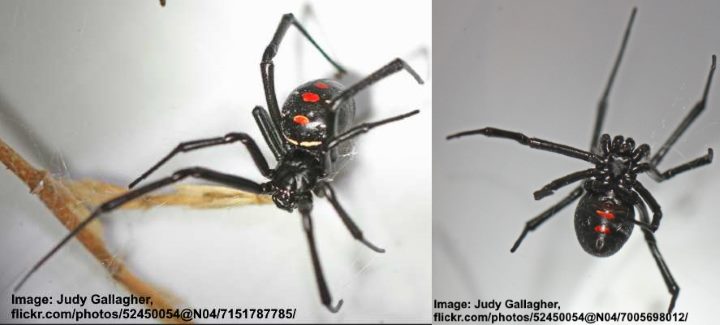
The northern black widow spider is identified by a black shiny body and red or dark orange dots on the back (left). The underside has two red dots (right)
The northern black widow spider has an oval, shiny black body with three or more dark orange or red dots on its back. The venomous black spider also has relatively long black legs that sometimes have dark orange bands on them. Juvenile northern black widows also have recognizable white stripes on their abdomens.
The northern black widow usually grows to 0.5” (13 mm). However, together with the black and orange legs, this black widow spider can measure 1.5” (38 mm).
The appearance of red abdominal markings is the way to tell a northern black widow apart from the southern species. For example, the northern black widow has a broken hourglass marking that looks like dots or two separate ‘V’ shapes.
Black and red spider identification: To identify a northern black widow spider, look for the line of vibrant red dots along the center of the shiny, bulbous abdomen.
Mediterranean black widow spider (Latrodectus tredecimguttatus)
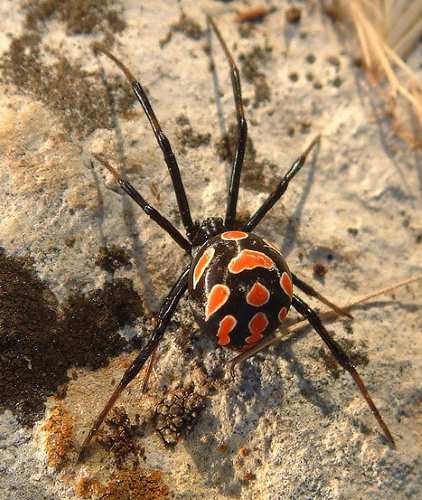
The Mediterranean black widow spider has black and red/dark orange patches with white edging and long legs
The Mediterranean black widow spider is recognized by its thirteen red dots covering its abdomen. Typically, the black widow has red or orange spots with white edging. However, some spiders in the species have orange or yellow markings on a black body. These venomous black widows measure 0.28” to 0.6” (7 – 15 mm).
Pictures of the Mediterranean black widow show that it has long legs relative to its black and red body. In addition, the tips of the shiny black legs appear to be dark orange or light brown.
Black and red or orange spider identification: To identify a Mediterranean black widow, look for the numerous red or orange markings on its rounded, bulbous abdomen.
Brown black widow spider (Latrodectus geometricus)
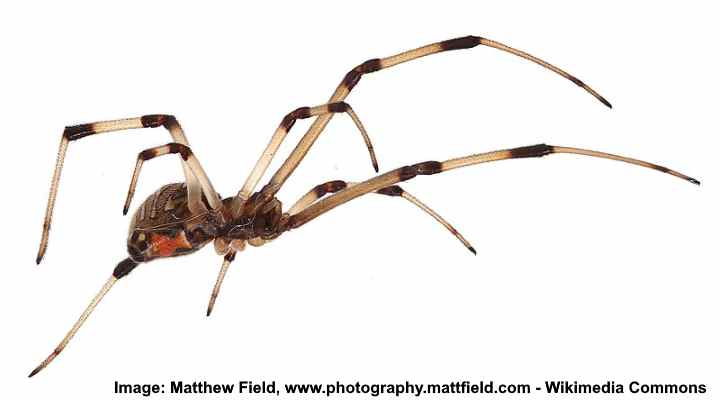
The brown black widow spider has a dark striped back and dark orange hourglass marking on its underside
The brown black widow spider has a dark brown to black body with a vivid orange hourglass marking on its underside. This dark-colored spider also has grayish or tan-colored stripes across its back. The spider’s other identifying trait is its creamy-white and brown striped legs.
The brown black widow spider measures 0.47” – 0.6” (12 – 16 mm) long.
Like all widow spiders, brown black spiders spin tangle webs to catch their prey. However, compared to black widow spiders, the bite of a brown black widow spider is not dangerous. Instead, the bite is usually comparable to a bee sting.
Other names for Latrodectus geometricus include geometric button spider, gray widow, brown widow, and brown button spider.
Black and orange spider identification: Brown black widow spider identification is by its dark brown or black abdomen with orange markings and a striped back.
Red widow spider (Latrodectus bishopi)
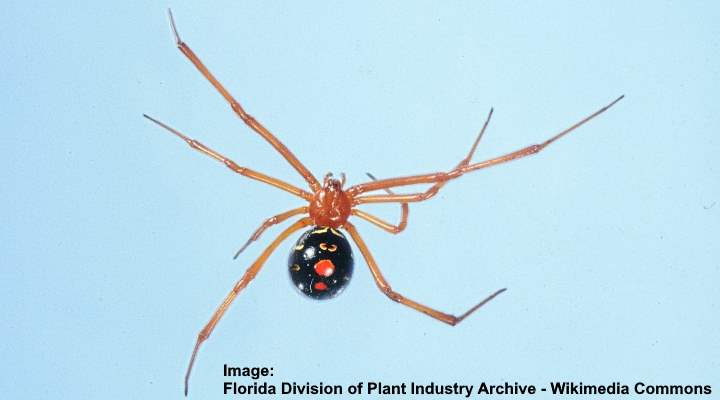
The red widow spider can be identified by its orange head and legs, with red spotted black abdomen
The red widow spider has a glossy black rounded body with at least two red markings and yellowish rings. The unusual characteristic of the red widow is its dark orange cephalothorax and long pointed orange legs. Red widows measure 0.5” (13 mm) long with a leg span of 2” (5 cm).
Red widow spiders are native to Florida, where they live in sand dunes. Although this is a venomous spider, it isn’t a threat to humans, and there are no recorded instances of the spider biting humans.
Black and orange spider identification: Red widow spiders are easy to identify due to their red-orange cephalothorax and shiny black abdomen. Look for the red dots ringed in yellow on its abdomen.
Black and Red Jumping Spiders (Phidippus)
Jumping spiders are native North American spiders with eight eyes, hairy bodies and legs, and distinctive identifying marks on their abdomens. The spotted patterns on the black spiders are usually orange, yellow, or white—depending on the species. Another identifying characteristic of jumping spiders is their green iridescent jaws.
Due to their thick legs, large body, and spiny look, it’s easy to mistake jumping spiders for tarantulas. However, most species of jumping spiders are identified by their two large central eyes, fuzzy legs and body, and ability to jump. In addition, jumping spiders don’t pose any harm to humans and are much smaller in size.
Red-backed jumping spider (Phidippus johnsoni)
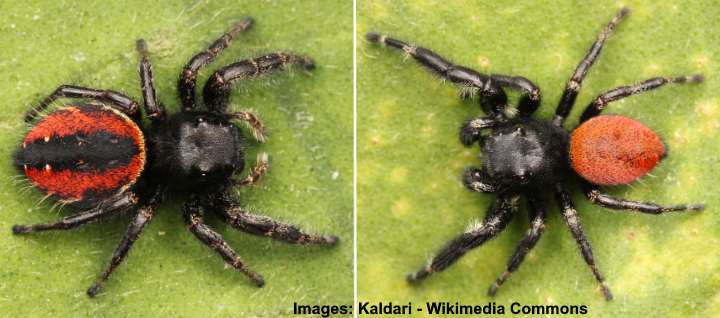
Red-backed jumping spider: female (left) and male (right)
The red-backed jumping spider has a black cephalothorax and orange-red abdomen. In addition, the female red-backed jumping spider has an identifiable black abdominal stripe. These black and orange spiders measure 0.35” to 0.55” (9 – 14 mm) long. Thus, this species is one of the larger types of jumping spiders.
The red-backed jumping spider is a type of tubular web-spinning spider. The black and red furry spider weaves a silken nest where it hides and lays eggs. Although these spiders can look menacing and bite, they are relatively harmless to humans and make good pets.
Pictures of red-backed spiders show that their body is covered in prominent black and white spines.
The way to identify female red-backed jumping spiders from the males is by their reddish abdomen and black stripe. Male red-backed spiders have an entirely red abdomen that is a strawberry shape. Females have a striped red and black abdomen with two red stripes on the edges and a black one in the center.
Black and red spider identification: The red-backed jumping spider is easily identifiable due to its brightly colored red abdomen, black head, and furry black legs.
Apache jumping spider (Phidippus apacheanus)
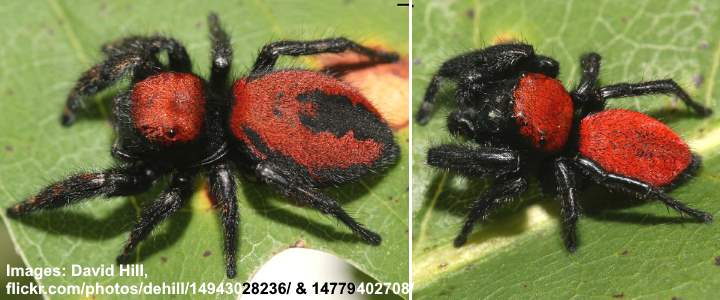
Apache jumping spider: female (left) and male (right)
This black and red furry apache spider is a species of jumping spider native to the United States. The jumping spider has a fuzzy red cephalothorax and abdomen. Its eight legs are entirely back. Like other red and black jumping spiders, the female spiders are larger than the male spiders and have a black stripe down a red belly.
Female Apache jumping spiders grow up to 0.86” (22 mm) long, excluding the length of the glossy black legs.
Black and red spider identification: The Apache jumping spider is identified by its brightly colored orange-red and black abdomen and cephalothorax.
Cardinal jumper (Phidippus cardinalis)
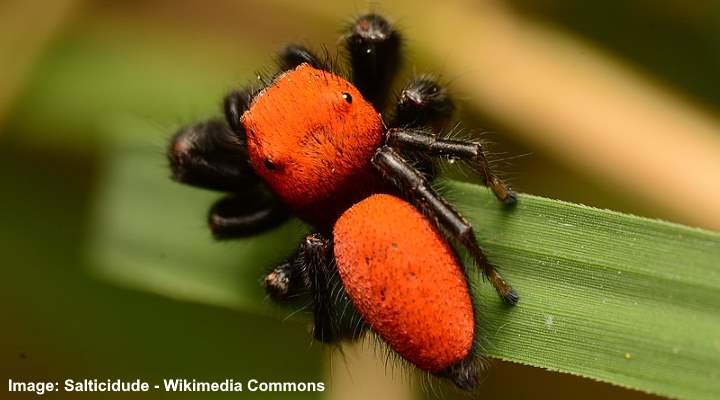
The cardinal jumper has red-orange furry body with black hairy legs
The cardinal jumper is a tiny red spider with black legs. The identifiable features of this colorful spider are its black hairy legs, furry orangey-red body, and two prominent eyes on the front of its cephalothorax. Cardinal jumper spiders measure around 0.4” (10 mm) long.
Cardinal jumper spiders mimic the appearance and habits of mutillid wasps, also called velvet ants. However, unlike the wasps, these spiders don’t sting.
Related reading: Insects that look like bees.
Black and orange spider identification: Cardinal jumper spiders are identified by their fuzzy orange-red body and black legs.
Whitman’s jumping spider (Phidippus whitmani)
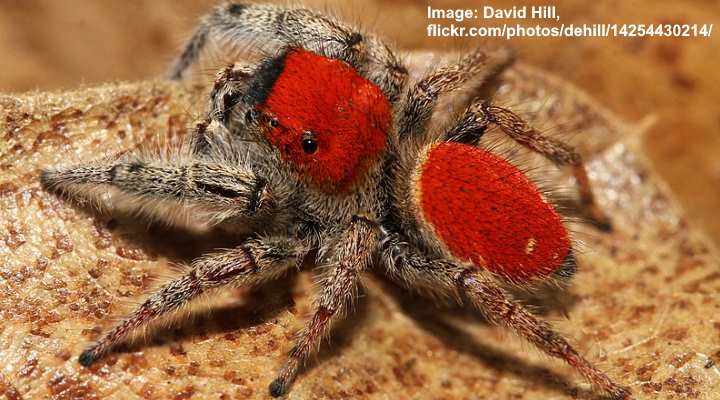
Whitman’s jumping spider is a red and black spider with white hairs on its legs
The male Whitman’s jumping spider is a grayish-black spider with a dark red furry abdomen and cephalothorax. The black and red spider has white setae (soft, thin spines) covering its legs, giving it a gray and red appearance. The tiny furry red spider only measures 0.4” (10 mm) long.
Black and red spider identification: The identifiable feature of Whitman’s jumping spider is its striking red top, gray-black underside, and grayish fuzzy legs.
Bold jumping spider (Phidippus audax)
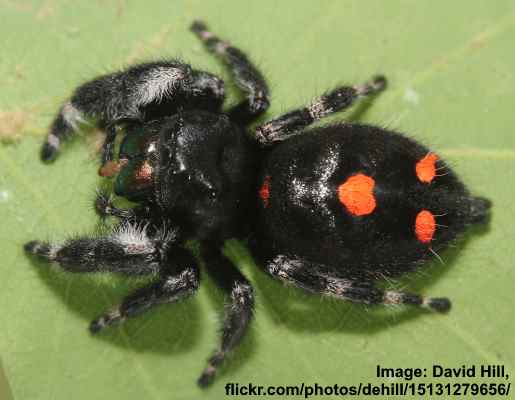
The bold jumping spider is characterized by shiny black body, three orange dots and striped hairy legs
The bold jumping spider is a black spider with three prominent orange-red markings on its shiny black abdomen. The tiny black and red spiders have spiny black and white legs, with their two front legs particularly large. Bold jumping spiders measure on average 0.43” (11 mm) long.
Black and red spider identification: A bold jumping spider is identified by its three bright orange or red markings on its spiny abdomen, orange band between the belly and cephalothorax, and black and white legs.
Black and Red Orb-Weavers (Araneidae)
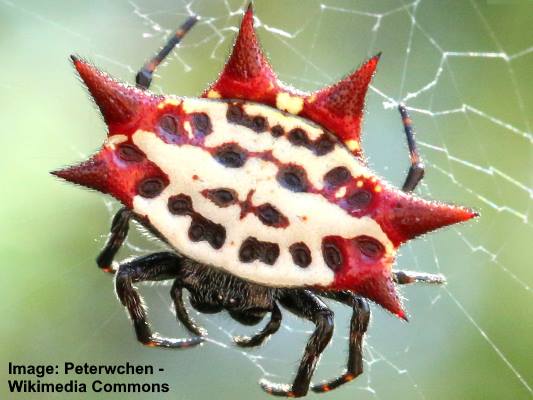
Spiny-backed orb-weaver (Gasteracantha cancriformis) is a red, black and white spider with a unique shape
A few species of orb-weaver spiders have black and red coloring. Orb weavers get their name from the circular webs they spin to catch their prey.
The spiny-backed orb-weaver (Gasteracantha cancriformis) is one of the most unusual black and red spiders. The spider has an identifiable broad, oval white abdomen with six prominent red spines, black dots, and black legs. These strange-looking spiders resemble crabs and are also called crab spiders. Black and red orb-weavers measure 0.35” (9 mm) wide and 0.5” (13 mm) wide.
Black and red spider identification: Spiny-backed orb-weavers have an easily identifiable oval body of white, red, and black. The six red spines on the spider’s back are its distinguishing characteristic.
Other Types of Black and Red Spiders
Among the nearly 130 families of spiders are various species of spiders classified as black and red spiders.
Red-headed mouse spider (Missulena occatoria)

A close up picture of male red-headed mouse spider
The male red-headed mouse spider has a smooth, shiny blue-black body and a dark red cephalothorax. Red-headed mouse spiders are highly venomous and native to Australia. Pictures of the red-headed mouse spider show it also has two large bright red jaws. This male black and red spider measures around 0.47” (12 mm).
The female red-headed mouse spider looks utterly different from the male species. The female species is a shiny black spider with a large brown bulbous abdomen.
Black and red spider identification: The red-headed mouse spider is easy to identify due to its bluish-black body, bright red jaws, and shiny red head.
Dwarf Spider (Hypselistes florens)
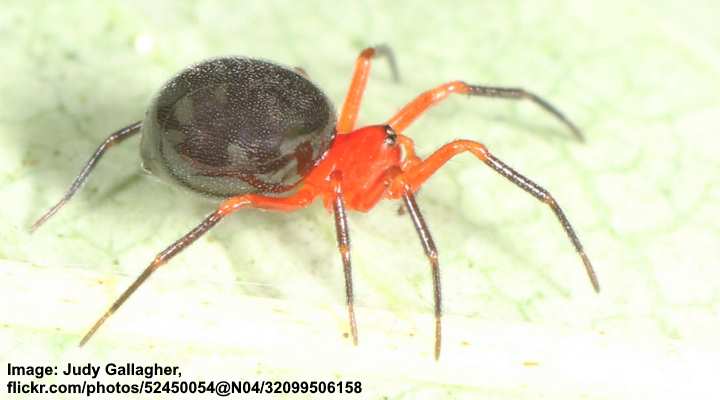
The dwarf spider is identified by an orange-reddish head and rounded black abdomen
The hypselistes florens is a species of black and reddish-orange dwarf spider with spindly brown legs. The orange-red and black spider has an identifiable rounded glossy ball-like abdomen that looks larger than the head. The orange head with its row of four black eyes gives this spider a comical appearance.
Because the tiny red and black spider only measures 0.11” (3 mm), you will only see its unusual features through a magnifying glass.
Black and red spider identification: The dwarf spider Hypselistes florens has a dark orange body, orange and brown legs, and an enlarged egg-shaped abdomen.
Blacktailed red sheetweaver (Florinda coccinea)
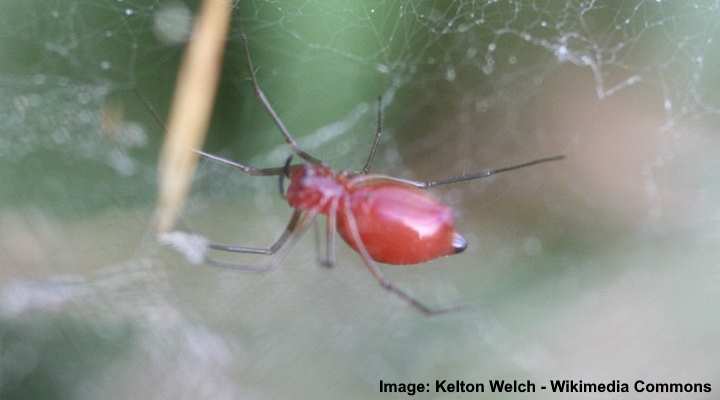
The tiny blacktailed red sheetweaver has reddish body, slender black legs and black tail-end
The blacktailed red sheetweaver is a species of dwarf spider with a reddish-brown body, spindly black legs, and a black spinneret at its tail end. Like most dwarf spiders, the red sheetweaver is small and only measures around 0.16” (4 mm).
Looking up close, pictures of the dwarf spider reveal eight eyes in two rows—two on the top and six on the lower row.
Blacktailed red sheetwearvers are also called red grass spiders. The red and black spiders are commonly found in lawns and grasslands in Florida and the southeastern United States.
Black and red spider identification: To identify a blacktailed red sheetweaver, look for its dark red elongated abdomen, black tail, and slender black legs.
Red-legged purseweb spider (Sphodros rufipes)
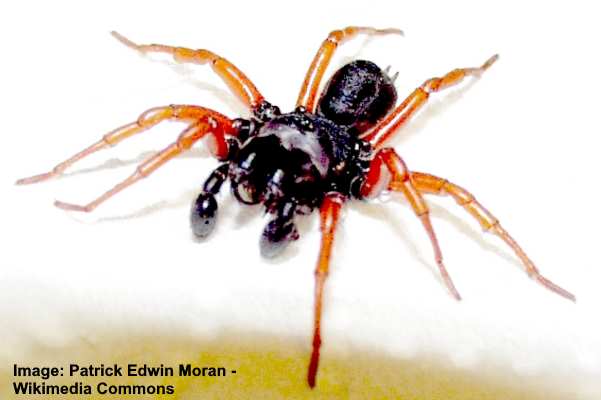
The red-legged purseweb spider has large black head, smaller abdomen and orange-red legs
The red-legged purseweb spider is a large shiny black spider with brightly colored reddish-orange legs. This robust black and red spider has a large head in comparison to its bulbous egg-shaped abdomen. Other identifying traits are its dark red to bright red legs that have a translucent appearance.
Red-legged purseweb spiders can grow up to 1” (25 mm) long. The spider spins a tunnel-like web and uses it to trap its prey. Typically, red-legged purseweb spiders don’t venture out of their webbed enclosure.
Black and red spider identification: The red-legged purseweb spider is identified by its jet black, smooth body, large black fanged jaws, and brownish-red legs.
Related articles:
